Buying advice & basics: Which board for windsurfing? All board groups explained
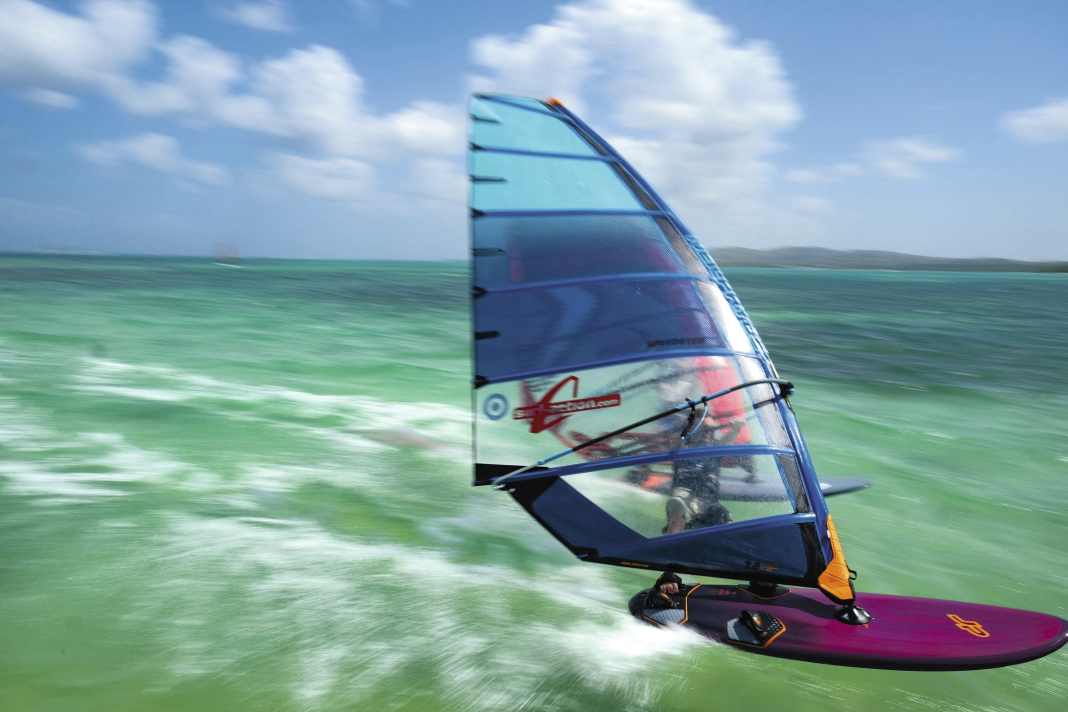





The biggest mistake you can make when buying windsurfing equipment? Getting hold of equipment that looks attractive but doesn't suit your needs at all! Imagine buying a cutting-edge board that shines at a fair price in your favourite colours in a shop window or classified ad, but is unsuitable for your riding style, level or size - a well-maintained, older board that suits you perfectly would definitely make for more fun on the water. We would like to help you find the right equipment for your needs with our equipment guide. What type of surfer am I, and which class or size makes sense for me? And above all: how do you recognise which type of equipment it belongs to and which components it harmonises with based on the characteristics of the material?
If you are looking for a board with a volume of 115 litres, it could be anything from a small slalom board to a freeride, freemove, freestyle or even a large wave board. This means you run the risk of buying a board that completely misses your requirements. Let's assume your days on the big school tanker are in the past and you are now looking for a board for planing and your first power jibes. The seller advertises his 115-litre waveboard as if it were the Holy Grail, with super glide and easy turning. The price is right, the volume apparently too - and you've already made a bad purchase. And no, the seller doesn't necessarily have to have evil intentions - they simply have a different perspective and may not know exactly what you're looking for. If you don't have the opportunity to get professional advice in a well-stocked surf shop, you first need to get an overview so that you can fish in the right pool.
1. longboard/WindSUP - the improvers
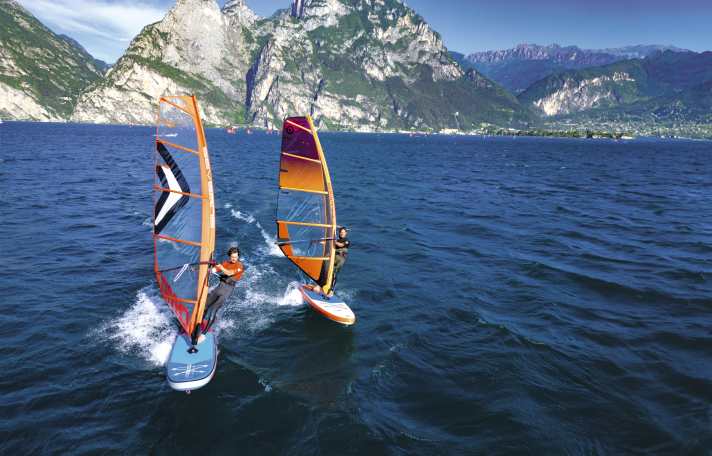
Target group: beginners & advanced, up to first attempts at gliding; light wind surfers; families.
The idea that longboards with daggerboards are only for beginners is one of the big misconceptions in windsurfing. Even if you already know how to glide, the wind (e.g. inland) can often be unpredictable and significantly reduce the fun. But don't worry: longboards are the real all-rounders. They also offer more experienced surfers the opportunity to get out on the water at almost any time. Thanks to their length of 260 to 350 centimetres, they are faster than all other boards when displacing, pull a decent amount of height with the daggerboard and can even be used for planing with the daggerboard folded in. They are also perfect for practising manoeuvres such as tacking, jibing or a few tricks. This makes them the ideal basis for later surfing on small fun boards.
Interestingly, the shapes of classic longboards have hardly changed for ages. "Length runs" was already the motto 20 years ago. For bargain hunters, this means that even a 20-year-old longboard is still up-to-date in terms of shape, as long as it is in the right condition. (Inflatable) windSUPs can also be an interesting alternative. They have similar dimensions to longboards and are versatile - you can use them for both stand-up paddling and windsurfing. However, you should be aware of this: A windsurfing longboard is basically also suitable for SUPing, but not every SUP is suitable for windsurfing. For this to work, the SUP needs a thread in the deck into which a base plate can be screwed. To minimise lateral drift, it would be ideal if a centre fin could be fitted. If this is not possible, there are practical solutions such as the Add-on Drift Stopper or the Ezywing. These systems allow additional fins to be easily attached to the board with a tensioning strap.
2. freeride boards - boards for the masses
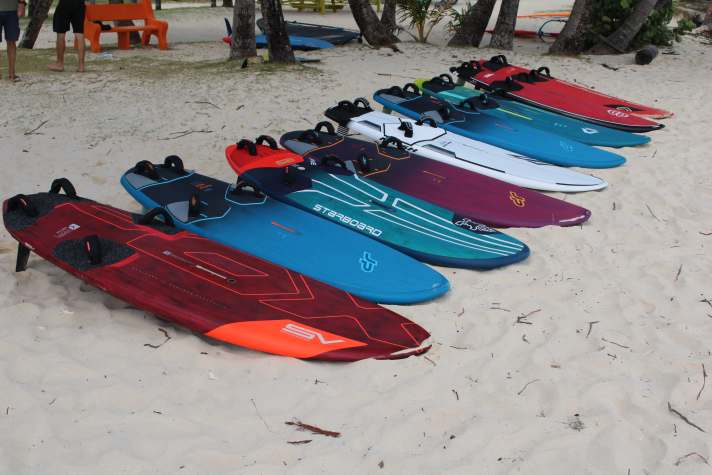
Target group: Beginners to planing surfing through to experienced freeriders. Ideally in combination with camberless sails or maximum 2-cam sails.
The most widespread board group is freeride. And not for nothing, because they are real all-rounders! With a length of 230 to 250 centimetres and a volume of 100 to 170 litres, they have been the standard for around 15 years. A Powerbox fin of 30 to 50 centimetres in length is usually installed in the tail.
Freeride boards are designed in such a way that they start planing early and are easy to handle. At the same time, they enable relaxed manoeuvres such as power jibes and duck jibes. Thanks to their great popularity, there are different options for the strap positions: There are positions further out on the edge for sporty, ambitious riders, while inside straps make cruising and learning easier, especially for beginners. But which board size is the right one? Beginners in glide surfing and those who have not yet reliably mastered the power jibe benefit from a little more volume. An excess of around 40 to 50 litres over your own body weight can be helpful - so even a sheet start is no problem. If you are confident in the straps and can master most manoeuvres, you can reduce the volume.
A look back shows: Freeride boards used to be longer and narrower. Between 2005 and 2007, there was a trend towards more compact and wider boards. For second-hand buyers, this means that a board built before 2006 is often narrower and more unstable than modern models. The difference is particularly noticeable in manoeuvres, and older boards are often at a disadvantage in wind holes. If you start out on a modern 150-litre freerider and then switch to an old model with a similar volume, you might feel like you're standing on a much smaller board. Nevertheless, the old favourites are certainly competitive with the new ones when it comes to planing.
3. freerace & slalom boards: the sports cannons
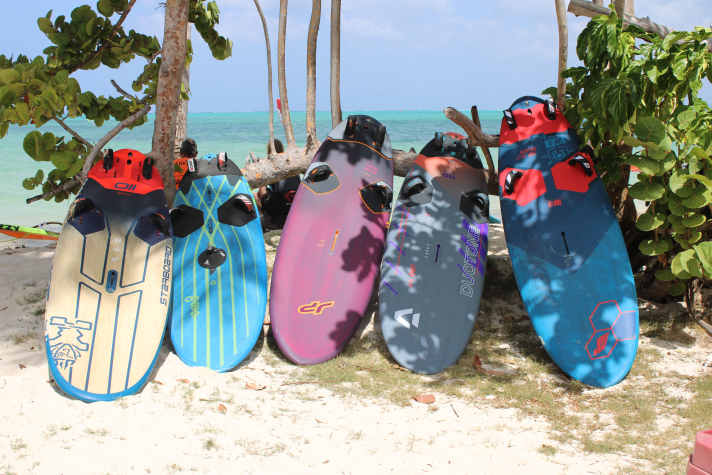
Target group: Surfers who can glide safely and use far-out loop positions; combination with camber sailing; regatta use; dual use of windsurfing & foiling.
Freerace boards are also in the 100 to 150 litre volume range and their dimensions are similar to freeride boards, which can certainly cause confusion when buying. Compared to freeriders, however, freerace boards are sportier and designed for maximum speed. They achieve this with a shorter gliding surface, wider tails and stance positions that are further out. The tail of these boards often features a slim, straight fin that is mounted in a tuttle box with two screws through the deck. This board category often lacks internal strap positions - a major drawback for beginners to planing surfing!
Slalom boards go one better when it comes to sportiness. These short, wide boards are designed for racing and are suitable for experienced surfers who like to use powerful camber sails. However, they are at a disadvantage compared to freeride boards when planing and jibing. Since 2018, many freerace and slalom boards have also been suitable for foiling. It is important to check the manufacturer's approval: Stickers or imprints such as "foil ready" or "approved for foiling" indicate that the fin boxes are reinforced. Foils can be fitted to older models, but there is no guarantee that the box can withstand this.
A tip on board size: A board that is suitable for foiling for the first time should have a tail that is as wide as possible. That's why freerace boards are only really suitable for foiling from around 125 litres. The smaller the board, the more of a balancing act foiling becomes. Specialised foil boards can offer much more in this respect.
Raceboards are long, narrow centreboards that are almost exclusively ridden by specialists in the relevant regattas. These boards are relatively fast even in light winds, but are rather unsuitable for pleasure surfing
4. freemoveboards - the all-rounders
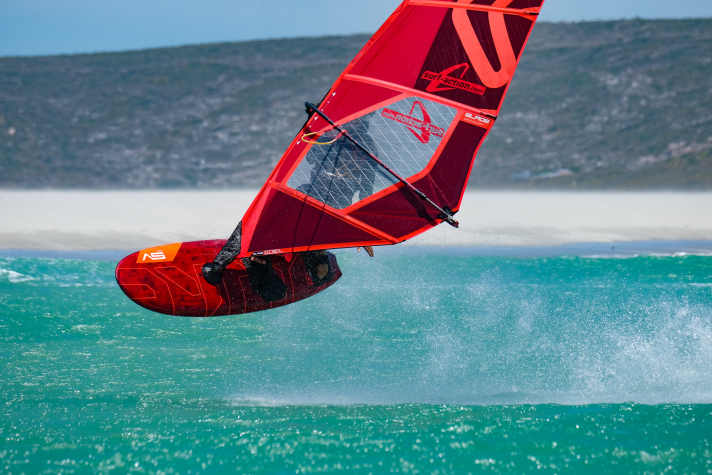
Target group: experienced surfers who can glide safely and make a water start - and want to cover everything from flat water to moderate surf and jumps with one board. The combination with wave or freemoving sails makes sense. If you are still practising planing and power jibing, freeride boards are better.
Freemoveboards are the more manoeuvrable alternative to freeride boards. They have narrower tails and a rounder rocker line, which means they don't start planing quite as early and are slightly less stable in manoeuvres. On the other hand, they offer better turning ability. The transition to freestyle waveboards is fluid: boards with a volume of over 105 litres are usually referred to as freemoveboards, while smaller boards are often referred to as freestyle waveboards or freewaveboards.
These boards are real all-rounders and designed for a variety of conditions. Whether fast heating and jibing on flat water, excursions into moderate surf waves or first jumps and freestyle tricks - all this is possible with freemove boards. The strap positions are flexible: from far inside, ideal for manoeuvres, to slightly offset to the outside, allowing use with three or four straps. The fin set-up also supports the different characteristics: curved single fins and a thruster set-up consisting of a medium-length centre fin and two small side fins are often included.
Freemoveboards have also changed over the years and became more compact and wider between 2010 and 2013. If a board is more than ten years old, it could be around ten centimetres longer than the current models. The most noticeable difference is in the fin set-up. Before 2014, small freemove or freestyle wave boards usually only had a single fin in the tail. Today, the thruster set-up with three fins is standard for sizes under 100 litres. This gives surfers more options for adapting the board to the respective conditions - whether flat water, bump & jump or small surf.
5. freestyle boards - time-lapse rotation
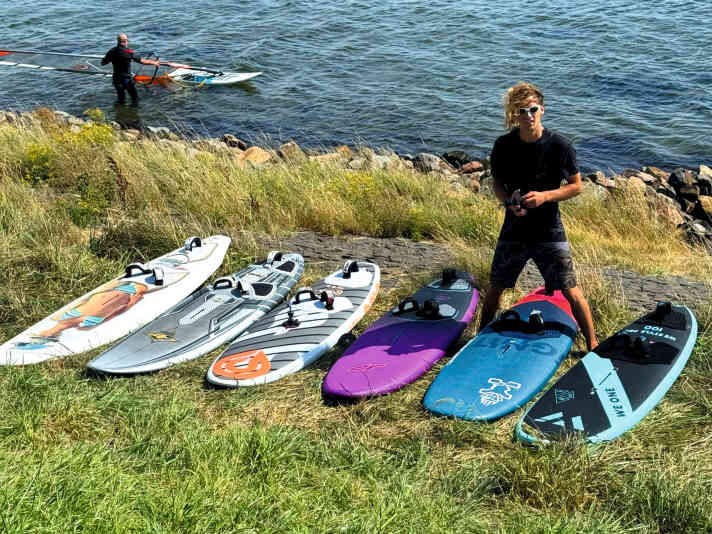
Target group: special boards for jumping and planing manoeuvres, in combination with freestyle or wave sails up to max. 5.5 m². Those practising planing manoeuvres should focus on the freestyle waver group, as these boards plane better and go upwind, become faster and run more cleanly on the edge.
The freestyle discipline has evolved incredibly quickly and the boards have been constantly improved to accommodate the new, increasingly unusual manoeuvres. There was a time when there were new tricks almost every day! Just as special as the manoeuvres, which became more and more radical, were the boards that went with them. Because there was a decisive turning point: it went higher into the air. 360s were no longer slid across the water, but turned completely in the air. Sails were ducked and loaded in back to catapult out of flat water high into power moves.
This change meant that the volume of the boards moved more towards the centre and the shapes became significantly shorter and more compact. If you're not interested in modern power moves such as Kono or Burner, you can confidently reach for older freestyle boards or even freemove boards. They are easier to surf, and classic tricks such as carving 360s or the odd spock can be performed wonderfully on them.
6. waveboards - Kauli's children
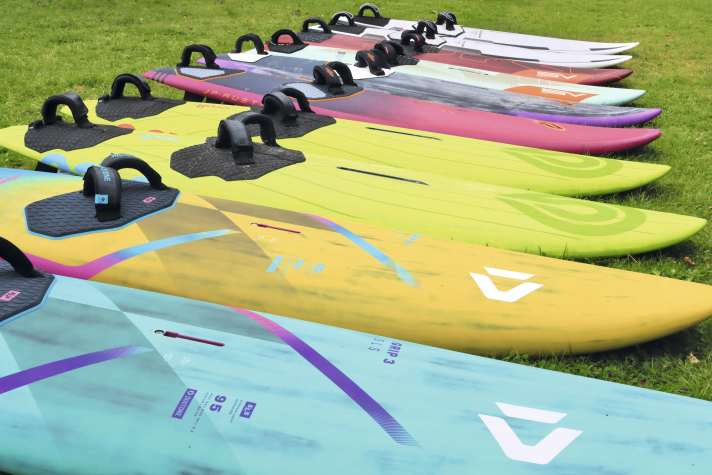
Target group: Mainly used in surf conditions, for jumps and wave riding. Use in conjunction with wave sails. If you have more days in flat water or chop than in the surf, you should take a look at the freestyle wave boards, as they glide better overall and offer more control.
Waveboards are made for use in real surf waves - and that means the swell wave on Lake Garda in strong winds or the IJsselmeer chop. If you want to use both straps and string together turns in the wave, the narrow tails and round rocker lines of the waveboards are just the thing. With the straps, you usually only have one position: far in.
The development of wave boards has changed rapidly in recent years. Riders such as Kauli Seadi, who became world wave champion three times between 2005 and 2008, have had a major influence on board design. Instead of the long and narrow single fin boards, he favoured more compact shapes with twinsers (2 fins), thrusters (3 fins) or quads (4 fins).
This trend later prevailed for almost all brands. Looking back, we can say that boards before 2008 were often narrow and long. Back then, an 85-kilo surfer would have chosen a 75 to 80-litre board in order to turn passably in the wave. From 2008, the first boards started to become wider, but initially remained single fins. From 2009, wider and higher-volume boards with multifin set-ups became the standard. These set-ups drastically improved the turning characteristics so that you could ride wider boards with more volume that still turned excellently.
The additional width and volume bring clear advantages when bobbing, crossing waves and planing. Today, the rule of thumb is: a volume that corresponds to your own body weight offers the greatest versatility in wave use.
7. foilboards - give you wings
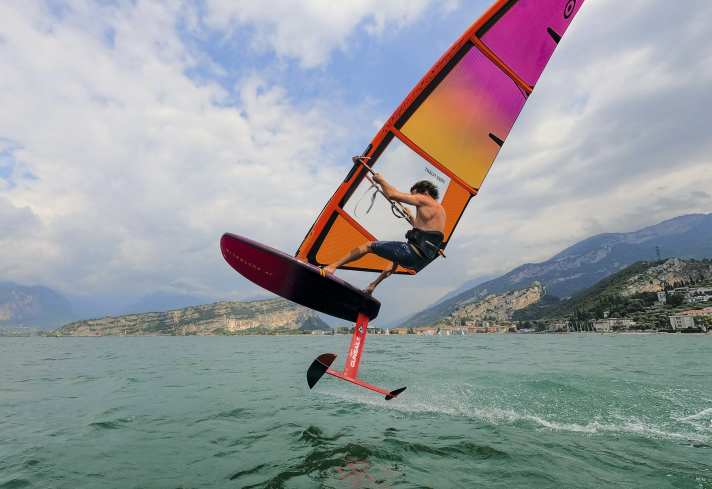
Windsurfing has really taken off since 2017, when the industry started offering special boards for foiling. These boards are significantly shorter than conventional windsurf boards with a similar volume, but have a wider tail. The basic rule: the wider the tail, the easier it is to control the foil and the more stable the flights are. This is precisely why freeride or freerace boards are only suitable for foiling to a limited extent, as they sometimes lack the necessary width in the tail. It is also important to mention that foil boards are specially designed for foiling and often do not work well or at all with a conventional fin. If you want to buy a used foil board, you should ideally buy a suitable foil at the same time. If you combine a foil and board from different brands, the components may not fit together perfectly. This can be a particular problem for foil boards with a tuttle box, as the position in which the foil sits on the board is fixed there. Boards with a double rail are more flexible, as the foil position can be adjusted, which makes it easier to combine different brands.
In terms of size, beginners to foiling should reckon with 30 to 50 litres more volume than their body weight and choose a model that is not extremely short (longer than 200 centimetres). This makes it easier to start and take off. If you can already pump actively and now want to concentrate on manoeuvres or jumps, you can also consider a more compact model under two metres.

